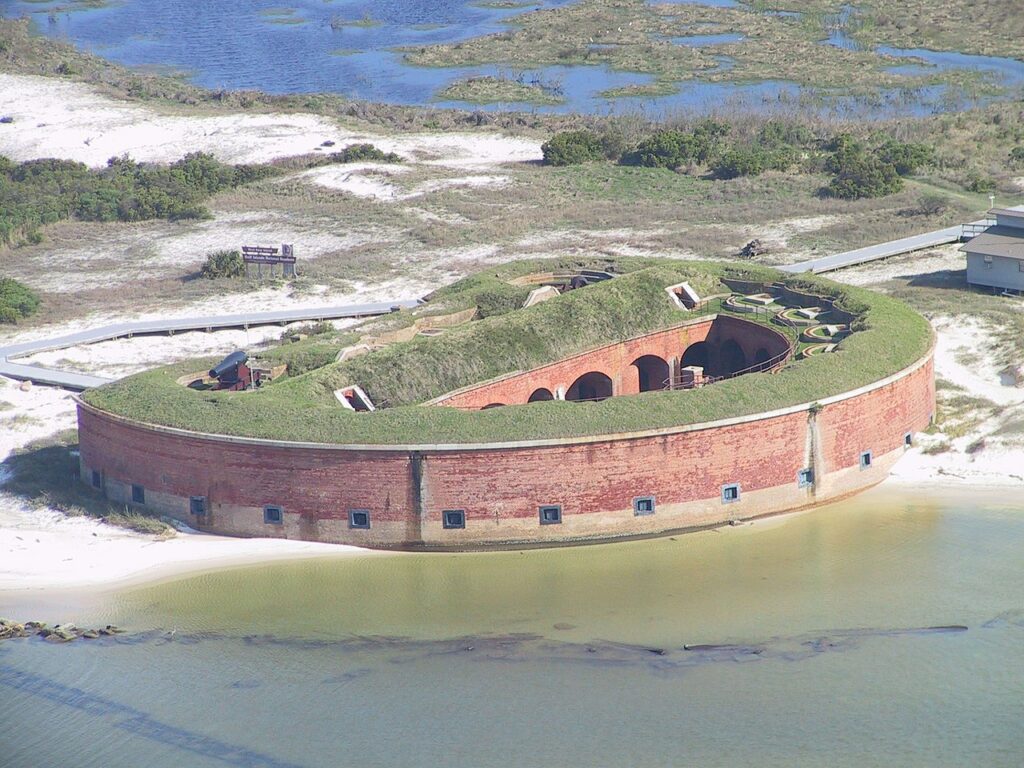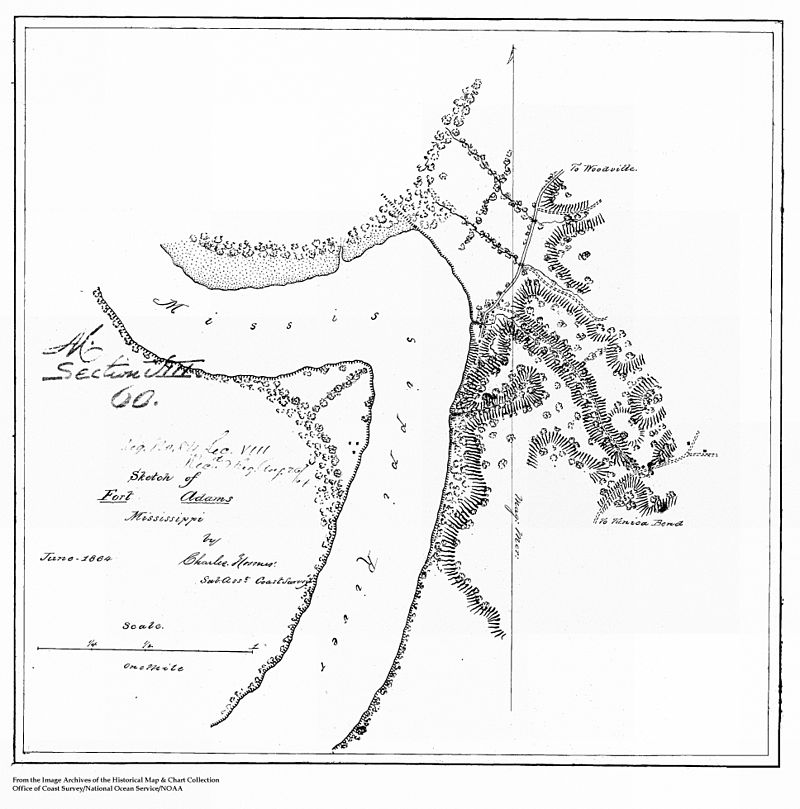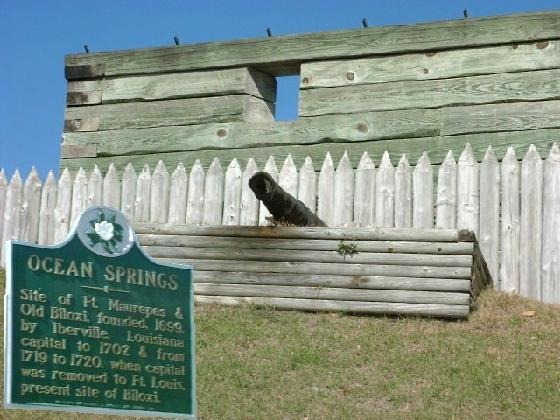With its strategically situated location along the Gulf of Mexico, Mississippi has long been a theater of crucial military operations. The state’s waters and lands have witnessed the ebb and flow of power struggles, from indigenous tribes to European colonizers.
From the whisper of secretive French missions to the deafening roars of Civil War battles, Mississippi has silently witnessed myriad transformative moments in North America’s history.
The numerous historic forts that dot Mississippi’s landscape offer a tangible connection to these past events. These forts, once bustling with soldiers, strategic discussions, and the sounds of cannon fire, now stand silent but resilient.
They serve as reminders of the hardships, triumphs, and tragedies that have shaped the state and, by extension, the nation. Read on as we journey through time and discover 10 Historic Forts in Mississippi.
10 Historic Forts in Mississippi
| 1. Fort Massachusetts | 6. Fort St. Pierre |
| 2. Fort Rosalie | 7. Fort Wade |
| 3. Fort Adams | 8. Fort Cobun |
| 4. Fort Pemberton | 9. Fort Burt |
| 5. Fort Maurepas | 10. South Fort |
1. Fort Massachusetts

Located on Ship Island, approximately 12 miles off the coast of Gulfport and Biloxi, Mississippi, Fort Massachusetts is a testament to 19th-century military architecture and the strategic importance of the Gulf Coast during the American Civil War.
The fort’s construction began in 1859 but was halted due to the outbreak of the Civil War in 1861. After the Union took control of the island in 1861, the construction was resumed and was completed in the late 1860s.
The fort was built with brick and concrete, featuring a classic design to resist both assaults by land and sea.
Civil War Significance
During the Civil War, Ship Island and, by extension, Fort Massachusetts played a crucial role for the Union. It was used as a staging area for the Union forces.
The island’s strategic position made it a prime location for launching assaults on the Southern coast and as a blockade point against Confederate shipping.
In 1862, the Union’s West Gulf Blockading Squadron, led by David Farragut, used Ship Island as a starting point for his successful campaign against New Orleans, a prominent Confederate city.
Hurricane Katrina
In 2005, Hurricane Katrina severely damaged Fort Massachusetts, one of the deadliest hurricanes in U.S. history. The storm eroded significant portions of the island, and the fort was inundated.
However, substantial efforts were made post-hurricane to restore and preserve the fort. Today, it stands as a testament not just to its history but also to the resilience of the Gulf Coast.
Tours
Tours of Fort Massachusetts are available for those interested in experiencing a piece of Civil War history. The only access to Ship Island and the fort is via passenger ferry, providing visitors a scenic journey across the Gulf of Mexico.
2. Fort Rosalie

Fort Rosalie was a colonial fortification established by the French in Natchez, Mississippi. The fort was named in honor of the Duchess of Pontchartrain, Rosalie Le Mothe. Its establishment in the early 18th century marked the French’s effort to secure their territories in the Lower Mississippi Valley.
The fort was strategically located near the Mississippi and Yazoo Rivers, making it a pivotal point for trade, communication, and defense against other European powers and Native American tribes.
The location enabled the French to control river traffic and bolster their regional presence against British and Spanish interests.
European Colonial Conflicts
The establishment and occupation of Fort Rosalie were not without strife. The fort played a central role in various European colonial conflicts, especially between the French and the Natchez people, culminating in the Natchez Revolt of 1729.
In November of that year, the Natchez attacked Fort Rosalie in response to French encroachments and demands. They killed most of the French inhabitants and took others captive.
This sparked a series of retaliatory campaigns by the French, leading to the eventual decline and dispersal of the Natchez people.
After the massacre, the fort was rebuilt and occupied by the French until 1763, when, as a result of the Treaty of Paris, it came under British control. Later, during the American Revolutionary War, the Spanish captured the fort, and it remained in Spanish hands until the United States took possession in 1798.
Historical Marker
The exact location of Fort Rosalie is marked with a historical marker for visitors. While the fort’s physical structures have long since vanished, its significance is commemorated at the Natchez National Historical Park.
This ensures that the rich history and importance of Fort Rosalie remain accessible to both locals and tourists.
3. Fort Adams

Fort Adams, located on the bluffs overlooking the Mississippi River, once held a commanding position at the southernmost point of a bend in the river.
This geographic significance made it a prime location for a fort, as it could control river traffic and access to the old Natchez Trace. This historic forest trail was of immense strategic and trade importance.
The earliest records of a military post near Fort Adams date back to the late 1700s, primarily during Spanish control of the region. However, the United States recognized the importance of this location and established a more permanent fortification in the early 19th century.
The fort was constructed during the tension that preceded the War of 1812. It was designed to deter British incursions and protect American interests in the Mississippi Territory. Fort Adams was garrisoned intermittently throughout its active years and underwent various modifications to its design and defenses.
Decline and Disuse
Despite its initial strategic importance, the significance of Fort Adams waned over the decades. As river channels shifted and trade routes evolved, the necessity of the fort diminished. By the mid-19th century, Fort Adams was largely abandoned by the military.
Once a symbol of strength and security, the fort’s brick walls have slowly succumbed to the ravages of time. Combined with the elements, erosion has taken its toll, leaving remnants of what was once a formidable structure.
Preservation and Legacy
Recognizing the historical importance of Fort Adams, it was added to the National Register of Historic Places. This inclusion ensures that its story and the broader narrative of the region’s colonial and early national past are preserved for future generations.
The remnants of the fort still stand as silent witnesses to a bygone era, evoking images of soldiers on the ramparts, watching over the Mississippi River, and guarding the crucial Natchez Trace.
4. Fort Pemberton
Situated near Greenwood, Mississippi, Fort Pemberton was a Confederate fortification built during the American Civil War. Constructed in the early 1860s, its primary function was to defend the Tallahatchie River and thwart Union advances into the interior of Mississippi.
The fort was constructed using earthworks, a popular and effective fortification method of the time, which involved building walls and barriers from dirt, often reinforced with wooden structures.
Earthwork batteries provided a robust defense and could absorb heavy fire, making them strategically crucial during the conflict.
Yazoo Pass Expedition
Fort Pemberton played a pivotal role during the Yazoo Pass Expedition in 1863. The expedition was a joint operation by the Union Army and Navy to attempt to bypass the Confederate defenses near Vicksburg, Mississippi.
The idea was to use the Yazoo Pass, a flooded area of the Delta, as a route to approach Vicksburg from the rear.
However, Confederate forces at Fort Pemberton effectively repelled Union forces attempting to navigate through the pass. The fort’s position allowed Confederate troops to control access to the Tallahatchie and Yalobusha Rivers, making it a formidable obstacle to Union movement in the region.
The Confederate success at Fort Pemberton contributed to the failure of the Yazoo Pass Expedition and delayed the Union’s eventual capture of Vicksburg.
Preservation and Legacy
Despite the passage of time and the wear of elements, the earthwork battery of Fort Pemberton remains relatively intact. These remnants testify to the fort’s military significance and the broader history of the Civil War in Mississippi.
Fort Pemberton is recognized for its historical importance, and efforts have been made to preserve and commemorate the site. Visitors can explore the earthworks, gaining a tangible connection to the events that unfolded there over a century and a half ago.
5. Fort Maurepas

In the quest for New World territories, French explorers and colonizers sought to establish a foothold along the Gulf Coast. Led by Pierre Le Moyne d’Iberville, a party of French settlers and explorers landed in the region in 1699.
Recognizing the strategic importance of the area, d’Iberville ordered the construction of Fort Maurepas, named in honor of Jean-Frédéric Phélypeaux, Count of Maurepas, who was France’s Secretary of State for the Marine at the time.
Strategic Importance
Located in what is now known as Ocean Springs, Mississippi, Fort Maurepas sat at the nexus of trade, exploration, and colonial defense. Its proximity to the East Pascagoula region meant it served as a gateway for further exploration into the continent’s interior.
The fort played a crucial role in solidifying French claims in the Mississippi Valley, laying the groundwork for subsequent settlements and forts further up the Mississippi River.
Life at Fort Maurepas
As one of the earliest European settlements in the region, life at Fort Maurepas was challenging. The settlers contended with unfamiliar terrain, potential conflicts with indigenous tribes, and the hardships of establishing a new colony from scratch.
However, the fort served as a hub for trade, interactions with Native American groups, and as a base for further exploration.
Decline and Relocation
Despite its initial significance, Fort Maurepas faced various challenges, including harsh weather conditions, flooding, and disease.
Recognizing the unsustainability of the fort’s location, d’Iberville decided to move the settlement to a more defensible and sustainable location. This led to the establishment of Mobile, further east, which would become the capital of French Louisiana.
Preservation and Legacy
While Fort Maurepas no longer stands, its significance in the history of the Gulf Coast and French colonial endeavors in North America is undeniable. The State of Mississippi has erected historical markers in Ocean Springs to commemorate the fort’s site and educate visitors about its foundational role in the region’s colonial history.
6. Fort St. Pierre

Situated near the bustling town of Vicksburg, Mississippi, Fort St. Pierre started its life as a French mission. The early 18th century saw a surge of French exploration and colonization activities in North America, particularly in the Mississippi Valley. Amidst this backdrop, Fort St. Pierre emerged as an essential outpost and fortification.
The transition from Mission to Fort
Initially serving as a mission, its purpose was to spread Christianity among the Native American populations and to foster positive relations.
However, recognizing the strategic value of its location near the Yazoo River, the French soon repurposed and strengthened the mission into a military fortification.
The transformation aimed to protect French interests, secure trade routes, and serve as a deterrent against potential threats, whether from rival European powers or hostile Native American tribes.
Strategic Significance
The Yazoo River was a vital waterway that provided access to the interior of the Mississippi Valley. Controlling a fort near such a crucial waterway meant having a significant trade, movement, and communication advantage.
Fort St. Pierre’s proximity to Loftus Heights, another significant site, further underscored its importance in the regional geopolitics of the time.
Operational Years and Decline
During its operational years, Fort St. Pierre played a multifaceted role. Besides its military functions, it facilitated trade with indigenous tribes and served as a base for further exploration and expansion into the Mississippi Valley.
However, the fort faced challenges, from disease outbreaks to tensions with surrounding Native American groups. Combined with broader shifts in French colonial policy and priorities, these strains led to its eventual abandonment.
While the physical remnants of Fort St. Pierre have faded with time, its historical significance remains intact. The fort serves as a testament to the complexities of the colonial era, highlighting the interplay between European ambitions, missionary zeal, and the realities of frontier life.
7. Fort Wade
Nestled in Jackson County, near the region of East Pascagoula, Mississippi, Fort Wade was one of the Confederate military posts constructed during the tumultuous times of the American Civil War.
The fort was strategically situated to protect the Confederacy’s vital routes and resources and deter Union advances.
The architecture of Fort Wade featured sturdy brick walls, which were commonly used in military fortifications of the time due to their resilience against artillery fire.
The fort also housed a powder magazine designed to store gunpowder and other ammunition safely. Such magazines were critical components of forts, ensuring that munitions remained dry and secure while readily accessible for defense.
Role During the Civil War
While Fort Wade might not have achieved the same fame as some other Confederate posts, such as Forts Jackson or Pike near Lake Pontchartrain, it played a crucial role in the Southern defense strategy.
Its position allowed Confederate forces to monitor and control the nearby waterways and land routes, providing an essential line of defense against potential Union incursions in the region.
Today
Today, the remains of Fort Wade serve as a silent testament to the strategic military maneuvers and defenses employed during the Civil War. For history enthusiasts and visitors, the fort offers a glimpse into the past, with its brick walls and powder magazine evoking images of soldiers, cannon fire, and the challenges of wartime defense.
8. Fort Cobun
Mississippi boasts a rich tapestry of historic forts, and among them, Fort Cobun stands as a significant emblem of the past. Like its counterparts, it has witnessed pivotal historical events and faced various challenges, both man-made and natural.
Origins and Role in the Civil War
Fort Cobun, located in Warren County, was primarily established during the American Civil War. Its strategic position made it invaluable for military operations, providing a defensible point against potential incursions and ensuring control over key routes.
Facing Nature’s Challenges
Much like other forts in the region, Fort Cobun was not immune to the forces of nature. The Mississippi region is often prone to natural disasters like floods, storms, and hurricanes, which have, over time, impacted the structural integrity of many historic sites.
Preservation and Public Engagement
The importance of Fort Cobun in the tapestry of American history underscores the need for its preservation. Efforts have been ongoing to ensure that this fort, along with others in the state, is maintained for future generations.
Restoring and protecting such sites remain accessible to the public, serving as educational touchpoints that offer insights into the nation’s turbulent past.
9. Fort Burt
Situated in the historic town of Port Gibson, Fort Burt held a strategic position in the southern United States.
Its proximity to key waterways and trade routes made it an essential military post, designed to guard the interests of the burgeoning American nation.
Role During the Battle of New Orleans
The War of 1812, which pitted the young American republic against the British Empire, reached its dramatic climax in the Battle of New Orleans.
This battle, fought in January 1815, was a defining moment in American history, showcasing the nation’s resilience and determination to defend its sovereignty.
Fort Burt played a role in this crucial conflict with its fortifications and strategic placement. As American forces, under the leadership of the indomitable Andrew Jackson, rallied to defend New Orleans, installations like Fort Burt provided vital support. They served as defensive points, supply depots, and rallying sites for American troops.
Walnut Hills and Preservation Efforts
Walnut Hills, another site steeped in historical significance, is near Fort Burt. Over time, as modernity has infringed upon these historic locales, there’s been a growing recognition of the need to preserve these places of memory.
The American Battlefield Trust, a non-profit organization dedicated to conserving America’s battlegrounds, has been at the forefront of these preservation efforts.
At Walnut Hills and other such sites, the Trust works diligently to maintain the land, ensuring that future generations can learn from and be inspired by the events there.
10. South Fort
South Fort occupies its unique place among the numerous historical landmarks scattered across the American landscape. As a sentinel of history, it has been a silent witness to various events and epochs that have shaped the nation.
While many forts in the country were birthed out of the necessities of wars and conflicts, South Fort’s foundation and purpose were rooted in the strategic imperatives of its time.
Ensuring a stronghold over key areas provided both a defensive and offensive advantage in military operations.
Challenges from Nature and Time
South Fort has faced its fair share of challenges, as have many historical structures. The forces of nature, including storms, floods, and erosion, coupled with the wear and tear of time, have left their marks.
Yet, despite these adversities, the fort has retained its essence and remains a significant emblem of the past.
Preservation and Current Status
Understanding the importance of such historic landmarks, there have been concerted efforts towards preserving and restoring South Fort.
These endeavors ensure that the legacy of the fort is not lost to future generations. Its inclusion in historical tours, educational programs, and public sites underscores its continued relevance.
Related: 10 Historic Forts in Nebraska
Protection and Preservation of Historic Forts
Preservation and protection of historic forts in Mississippi is vital to ensure that these significant military structures remain as a testament to the region’s history.
One of the ways to achieve this goal is through the support of non-profit organizations, such as the American Battlefield Trust, which focus on safeguarding historic sites and providing educational resources.
These organizations often encourage people to donate or volunteer their time and resources to help protect these forts and other historic sites.
Engaging the Public
This allows the public to be actively involved in preserving the rich heritage of Mississippi’s military past. Additionally, many of these forts have been recognized by the National Register of Historic Places and designated as National Historic Landmarks, which contributes to their protection and promotes public awareness of their importance.
Spotlight on Fort Massachusetts
One notable example is Fort Massachusetts on Ship Island, located in the Gulf of Mexico. This fort, which served as a staging area for Union forces during the American Civil War, is currently managed by the Gulf Islands National Seashore and is accessible to the public through guided tours.
The tours are available via passenger ferries and provide visitors with opportunities to learn about the fort’s history, Union advances, and Confederate defense along the Gulf Coast.
Legacy of Fort Maurepas
Another fort that holds a place in Mississippi’s history is Fort Maurepas. Although its exact location is unknown following damage from Hurricane Katrina, it remains an important site as one of the earliest French forts in North America.
Efforts to protect this and other forts often include the installation of historical markers, highlighting key events, and notable figures like Andrew Jackson.
Remembering Loftus Heights
Meanwhile, at Loftus Heights, overlooking the Yazoo River, the earthwork battery is preserved as a historic site where Union forces attacked Confederate soldiers during the Battle of Chickasaw Bayou.
In the case of forts like this, preservation work focuses on maintaining the structure and surroundings, so visitors can better understand the region’s military heritage.
Related: 10 Historic Forts in Nevada
Mississippi’s Historic Forts: Standing Against Nature’s Wrath
Mississippi is home to numerous historic forts that have played significant roles in North America’s history. These forts have withstood various challenges, including the forces of nature like hurricanes.
Fort Massachusetts: A Testament to Resilience
One of the most notable forts in Mississippi is Fort Massachusetts on Ship Island, located in the Gulf of Mexico. This fort served as a staging area for Union forces during the American Civil War.
In 2005, Hurricane Katrina seriously damaged the structure, requiring extensive restoration. Today, Fort Massachusetts is part of the Gulf Islands National Seashore, and visitors can access the island by a passenger ferry.
Fort Pike: Guardian of the Rigolets Pass
Another noteworthy fort is Fort Pike, which guarded the Rigolets Pass along the coast of Mississippi. Constructed with brick walls and earthwork battery, it protected New Orleans during the Seminole Wars and the War of 1812.
its historic significance, Fort Pike was heavily damaged by Hurricane Katrina. Currently, it remains closed to the public due to ongoing repair efforts.
Fort Maurepas: From French Mission to Hurricane’s Path
Fort Maurepas in Jackson County also faced the wrath of Hurricane Katrina. Established as part of the French mission in the Gulf Coast, Fort Maurepas was the earliest settlement in the region and an essential military post.
The hurricane destroyed the replica fort on the site, which had been constructed for educational purposes.
Other Forts: Bearing the Brunt of Nature
In addition to these forts, Mississippi features several other historic military sites that have experienced natural disasters, such as Fort Adams, Fort Wood, and Fort Macomb.
Many of these forts are listed on the National Register of Historic Places or have state historical markers commemorating their significance.
Preservation Efforts: Honoring the Past
Despite the destruction caused by natural disasters like hurricanes, efforts continue to preserve and restore Mississippi’s historic forts. These sites offer valuable insights into the past and serve as reminders of the area’s rich military history.

Cory is a website owner and content creator who enjoys fishing, history, coin collecting, and sports, among other hobbies. He is a husband and father of four.
Romans 15:4 For whatever was written in former days was written for our instruction, that through endurance and through the encouragement of the Scriptures we might have hope.

